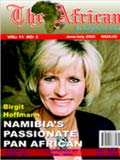|
|
Africa's First Diesel Multiple Train Unit |
Namibia is the first African country to introduce
the Diesel Multiple Unit train (DMU). It is one of
the world's most sophisticated trains ever. It is
called the OMUGULUGWOMBASHE STAR in the local
Oshiwambo language. It has a maximum speed of 120
kilometers per hour and a lifespan of 15 years.
 The train is the first of its kind in the
entire continent: manufactured in China
after comprehensive research
worldwide for the best quality and
standards. The train is the first of its kind in the
entire continent: manufactured in China
after comprehensive research
worldwide for the best quality and
standards.
The engineers investigated in order to come up with the most flexible
technology and to produce the best combined
technology quickly. They
achieved and initiated this project in
2002 and it was ready in 2004.
The train
consists of three technologies designed
in three different countries: Namibia,
Britain and China.
The Namibian engineers designed the
specifications while the British did the
engine and the body was designed by
Chinese.
Namibia is one of two countries in the
Africa with a good quality railway
network that meets the world standards.
The slow pace of the previous trains
hindered efficiency and speed for the
delivery of goods and services, hence
was a major contributing factor that
influenced the design to makea better
train, and On the other hand, the trains
are too old, the youngest being 36 years
and this increases maintenance costs.
The old trains are slow due to their
'Bogies' (wheels which are) designed in
such away that they are fixed to the train
and therefore, if the train goes at a
speed higher than 60km/hour they can
cause accidents. Owing to the Namibian
sloping terrain, the new train is designed with flexible bogies, which
allows it to move with the terrain without
slipping off the rail, thus allowing it to
travel much faster.
According to Mr.
Hauuanga, the Engineering General
Manager at TransNamib Holdings
Limited,the train was designed only
after thorough investigations were
made in different countries worldwide
with the best trains.
The train is manufactured in China, since
it is one of the best manufacturing
countries in the world for the best
quality in technology, most efficient and
is the country that offered the best
package including 15 months
guarantee,spare parts for 15 months
and engineers sent from China to
maintain the train and to trainNamibian
engineers to maintain the machines.
This train cost TransNamib Ltd N$ 16
million and included 1 train set, 30 oil-tank wagons and 4 locomotives. The
company expects a payback period of
10 years and that this investment to be
profitable.
The new Rolling stock is faster and will
increase the company's efficiency to
transport to different parts of the
country.
TransNamib is full of
confidence that this is a good
investment and is just one of the
developments to achieve the country's
goals and objectives for Vision 2030.
In comparison to other modes of
commercial transport like air and
commercial buses, a train is much
cheaper.
However, comparing this to the
rates of commercial Black market
services for example, the normal train
fare from Windhoek to Oshivelo is N$
140 for economy class, N$ 210 for
Business class. In contrast the black
market costs N$110.
The new trains offer excellent quality
services including: air conditioned
coaches, spacious rooms and
entertainment (like DVD'S).
The TransNamib improved services value
comfort,safety,and convenience. The
train stops at all train stations
countrywide.
Currently, railway construction is
underway from Oshivelo to Oshikango
and from Aus to Luderitz.The railway
currently covers most major towns of
Namibia, excluding a few in the
northeastern part of the country that
will be covered in the near future. ·TA· |
|
|
|
This Issue |
 |
|

